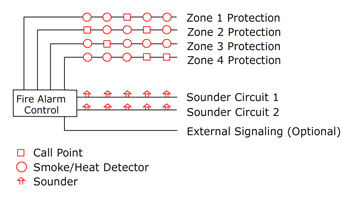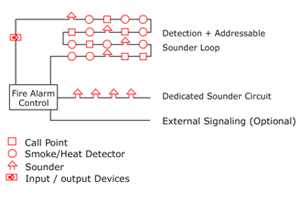Conventional vs Addressable Fire Alarm System: What Are the Difference?
Fire Alarm system is a system of devices connected by wire or wirelessly to detect and indicate individuals of fire hazards in the area. Here we will discuss the two main types of alarm system available on the market.
Conventional Fire Alarm System
This is the most common type of fire alarm system around. They are commonly used in smaller building such as stores, homes and restaurants. They are also an ideal choice for people with smaller budgets.
A conventional fire alarm consists of 1 or more circuits, connected in parallel. They are simple to setup, easily integrated with other brand name manufacturers’ devices and do not require configurations.

Picture 1. Typical Wiring Diagram of a Conventional Fire Alarm System
To indicate fire in a building, each floor is typically divided into a zone. A building with 3 floors can be subdivided into 3 zones, with each zone containing a wire connecting multiple initiating devices (e.g. detectors and call points).
The drawback of a conventional fire alarm system is its limitation in determining the exact location of the fire in the zone. Since each zone has multiple devices connected to it, a fire alarm notification would only notify a zone is triggered, without specifying the exact device that was triggered. In the event of fire, every second counts and the delay could cause serious damages to properties and persons in the building.
Addressable Fire Alarm Systems
Addressable fire alarm systems are the cousins to the conventional type. They are traditionally used for complex projects or large buildings. Nevertheless, with technological advancement, they have become more affordable and are used more frequently on smaller sites as well.
As the name states, each device in the system has an “address”. In other words, each detector, call point, interface, sounder and beacon are connected directly to the control panel. When the alarm is triggered, the controller can pinpoint the location where the fire is detected, or where the device is triggered.

Picture 2. Typical Wiring Diagram of an Addressable Fire Alarm System
Most addressable fire alarm control panel has a built-in display for event log. The detector can also report a smoke concentration value to the main panel. In some models, the detectors can adjust their sensitivity according to the environment or time of the day. Sometimes advanced features could be set up to conduct fire analysis.
So in short, here the pros and cons of each type of alarm system:
Conventional Fire Alarm Systems
Pros
- Cheaper Alarm Panel & Devices
- Simple setup
- No compatibility issues between different brands
- Suitable for smaller sites where locating each device is not necessary
Cons
- Can not exactly pinpoint the location of the fire
- Wiring & installation may be expensive
Addressable Fire Alarm System
Pros
- More efficient and effective method of locating fire
- Can display event log for past events
- Some models can adjust parameters of each device’s sensitivity
- Suitable for larger sites where locating each device is essential, in case of fire
Cons
- More expensive
- Compatibility between different brands might be an issue
- Complicated setup, configuration required

